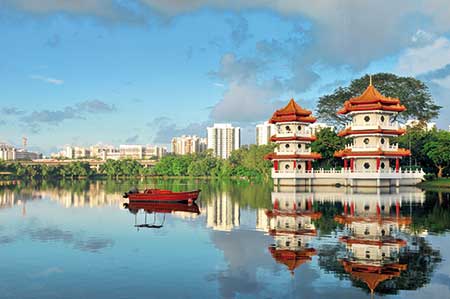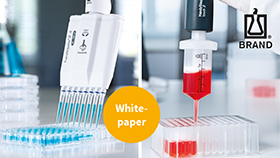Majulah Singapura
From Fishing Village to Asia’s Biopolis (Pt II)
Career strategies for young European scientists
by Ralf Schreck, Labtimes 04/2013
Page 1 | Page 2 | Page 3
In the second of the two-part series on Singapore, Lab Times will focus on Singapore’s major research performers and initiatives as well as on concrete fellowship opportunities.
The Agency for Science, Technology and Research (A*STAR) is Singapore’s leading agency, with the mission to promote world-class scientific research and talent for a knowledge-based and innovation-driven economy. Initially established as the National Science and Technology Board in 1991 with the objective to raise the overall level of science and technology in Singapore, it was renamed in 2002.
Under the current five-year Research, Innovation and Enterprise Plan of the Government running until 2015, about €4 bn or 40% of the national non-defence-related R&D expenses are earmarked for A*STAR. In comparison to the last funding period, this constitutes a significant 20% hike and provides proof of the Government’s continued commitment to invest into science and innovation.
A*Star was born in 1991
A*STAR employs a total of almost 4,000 people and about half of its scientists are from abroad. It operates 14 biomedical, physical and engineering research institutes as well as six consortia and centres. They are concentrated primarily at Biopolis, a large-scale €350 million development project, which generated 220,000 m2 floor space with several buildings for biomedical research, and at the close-by Fusionopolis, which will provide more than 270,000 m2 of business park and lab space after completion of phase II next year. In addition, A*STAR also supports extramural research at universities, hospitals and research centres in collaboration with additional local and international partners.
A*STAR is headed by its chairman Lim Chuan Poh, a former chief of Defence Force, its deputy chairman Tan Chorh Chuan, the President of the National University of Singapore, and the A*STAR managing director Raj Thampuran. The A*STAR Board is composed of more than 20 key officials from the local Government and respective boards, higher education and research institutions (Harvard Medical School, Oxford University, Imperial College) and business (Procter & Gamble, Takeda Pharmaceuticals, GlaxoSmithKline). Senior management include A*STAR Chief Scientist and pioneer in p53 tumour suppressor research, Sir David Lane, and A*STAR Senior Fellow and 2002 Nobel Laureate, Sydney Brenner.
Major entities include the A*STAR Graduate Academy (A*GA) as talent pipeline and the Biomedical Research Council (BMRC) as major driver of the Biomedical Science (BMS) Initiative of Singapore. The Science & Engineering Council (SERC) is in charge of coordinating public sector research and development in physical sciences and engineering; the A*STAR Joint Council supports interdisciplinary research and three commercialisation units including the Exploit Technologies Pte Ltd or the Experimental Therapeutics Centre take care of technology transfer, intellectual property rights management and the advancement of A*STAR’s discoveries into commercial products and clinical applications.
A*GA, the A*STAR Graduate Academy, is a major graduate scholarship provider in Singapore. Since 2001 more than 1,100 scientific talents have been selected to pursue undergraduate, graduate or postdoc studies in biomedicine, physics or engineering at the best institutions, locally or abroad. A*GA receives advice from an International Advisory Panel with prominent faculty members from leading universities, including Princeton University, Imperial College and Karolinska Institutet.
Medical tests required for scholarships
Several fellowships and awards for international talents are provided: the Singapore International Pre-Graduate Award (SIPGA), the Singapore International Graduate Award (SINGA), together with the National University of Singapore (NUS), the Nanyang Technological University (NTU) and the A*STAR Research Attachment Programme (ARAP). ARAP provides the opportunity for a foreign PhD student of a partner university to work for one or two years at an A*STAR institution, under joint supervision by investigators of A*STAR and the home university. Additional fellowships are limited for Singaporeans or foreigners who have to become a Singaporean before departure.
For example, the National Science Scholarship provides opportunities for PhD students to pursue their doctoral studies abroad. They receive the usual allowances for up to five years. Successful candidates are expected to spend a one-year research attachment at an A*STAR institution, before taking up their PhD studies and have to commit to return to Singapore and work at an A*STAR institution for four additional years. For postdocs with Singaporean citizenship the A*STAR two-year International Fellowship (AIF) and the A*STAR Graduate Scholarship are available and are linked to a one-year service commitment upon return to Singapore. Whereas fellowships are awarded on the basis of referee reports, a short research proposal and academic credentials, scholarship candidates have to pass two rounds of interviews as well as psychometric and medical health tests.
Committed to commercial success
Biomedicine was picked as one of Singapore’s future key economic drivers in the year 2000, when the Biomedical Sciences (BMS) initiative took off. As top priority of the Government, the BMS initiative is directed by the Research, Innovation and Enterprise (RIE) Council under Prime Minister Lee Hsien Long. The Executive Committee with a coordination role is assisted by an International Advisory Council compiled of preeminent scientists, such as the UK Stem Cell Foundation chairman Sir Richard Sykes, the Nobel Laureates Sydney Brenner and Rolf Zinkernagel or HHMI Vice President Jack Dixon. The three key agencies in charge of implementing BMS are the Biomedical Research Council (BMRC) of A*STAR, which is providing funds and support to public research initiatives, the Economic Development Board promoting R&D activities and manufacturing in the business sector, and, last but not least, the National Medical Research Council (NMRC) of the Ministry of Health, focusing not only on research at healthcare institutions and on training of clinician-scientists but also on competitive funds for individual research projects.
Since the start of the initiative, biomedical research in Singapore has been evolving along three five-year RIE plans with differing objectives, targets and major investments into state-of-the-art infrastructure. The levels of ambition and investment are still huge. Not every initiative or programme has been an unmitigated success, so that Singapore has had to learn the hard way and recognise that money can’t buy everything.
In the first phase, up until 2005, the focus was on developing a solid framework for basic biomedical research, including the areas molecular and cell biology, genomics and proteomics, bioengineering and -processing, nanotechnology and computational biology. Biotech, pharma, medtech and healthcare services developed into major focus areas. In the second phase (2006-2010), translational and clinical research disciplines were pushed with continuous support of basic sciences. The Institute of Medical Biology and the Institute for Clinical Sciences were launched and several consortia bringing together human and capital resources in translational areas, such as the Singapore Stem Cell Consortium, the Singapore Immunology Network or the Singapore Bio-Imaging Consortium, were initiated. In the ongoing third phase (2011-2015), the commercialisation of biomedical research has now reached a new level and 70% of Singapore’s research funds will be earmarked for industry-oriented public and corporate R&D. One focus is on so-called mission-oriented programmes in areas with high growth potential, such as Biologics, MedTech and Nutraceuticals/Cosmeceuticals. Interdisciplinary technology platforms will be developed on demand and for the support of the business sector. And a novel one-stop-shop, the Singapore Biomedical Sciences Industry Partnership Office, will function as door-opener for multinational corporations wishing to set up cooperations in Singapore.
Grants linked to mandatory residence
Four autonomic public universities constitute the main pillars of higher education in Singapore. The National University of Singapore (NUS) and the Nanyang Technological University (NTU) are research-intensive institutions offering an extensive range of study courses and will be introduced in more detail below. In addition, there are the Singapore Management University (SMU) and the Singapore University of Technology and Design (SUDT). The upgrade of two existing institutions is under discussion: the private Singapore Institute of Management University (UniSIM) is expected to start full-time degree programmes soon, whereas the Singapore Institute of Technology (SIT), which is offering niche degree programmes together with overseas universities, will start to confer own degrees by 2015. The higher education system of Singapore is completed by five polytechnics (Nanyang, Ngee Ann, Republic, Singapore and Temasek), which offer practice-oriented training leading to diplomas in chemistry, biosciences, engineering and other disciplines. At universities about 77,000 and at polytechnics 85,000 students are enrolled.
In the past academic year, Singaporeans accounted for 79% of the student intake, whereas international students and permanent residents made up 16 and 5%, respectively. The intake of international students has been frozen by the Government at the 2011 numbers upon increasing pressure from the “Singaporeans First” lobby.
In addition, large differences in the participation of international students in different study courses exist. For example, the percentage of foreign medical students is in the lower range, whereas in some engineering courses international students account for more than a half. At the PhD student level just a fifth of all 3,000 doctoral students at NTU and a third of the 480 students at NUS Graduate School for Integrative Sciences and Engineering are Singaporeans.
Tertiary education in Singapore remains heavily subsidised. Comprehensive tuition grants are offered by the Ministry of Education. In order to benefit, permanent residents and international students have to sign an agreement and commit themselves to stay and work for up to three years in Singapore after graduation. For other fellowships offering full coverage and certain study courses, such as medicine, it is required to extend the Singaporean visit by up to six years. The Government, in turn, helps graduates to secure a job according to their specific skills. Failure to meet the bond entails a refund of the full grant plus interest. To get an idea: tuition fees for the academic year at NUS Medical School are €75,000 for full payers, €14,000 for subsidised Singaporean students and €28,000 for subsidised international students.
Educating tomorrow’s workforce
Asia is expected to account for roughly three-quarters of the global demand for international higher education in 2025. To get a considerable slice of the cake, the Singaporean Government disclosed a long-term strategy for the development of its workforce in the late nineties already. Several programmes, such as Manpower 21 and World Class Universities, were installed.
In frame of the Global Schoolhouse Initiative, leading institutions from abroad have been attracted to Singapore and received generous start-up loans and subsidies. The initiative’s target is to attract 150,000 full-fee paying international students and 100,000 international corporate executives on training to Singapore by 2015. Branch campuses were opened, for example, by the New York’s Tisch School of the Arts, the University of Nevada Las Vegas or the Technical University of Munich. Other ventures were discontinued. The University of New South Wales, for example, closed its branch just after one semester and the effort of Johns Hopkins University was terminated in 2006 after disagreements over subsidies. The uncontrolled growth of hundreds of private institutions operated by domestic or international education providers has been partially restrained by the Private Education Act from 2009. According to the Economic Development Board, there are currently about 1,200 private education organisations in Singapore enrolling more than 100,000 students and also meeting the demand for executive education and corporate training by the more than 7,000 multinational corporations and 1,000 foreign small and medium companies.
Page 1 | Page 2 | Page 3
Last Changed: 08.04.2013







